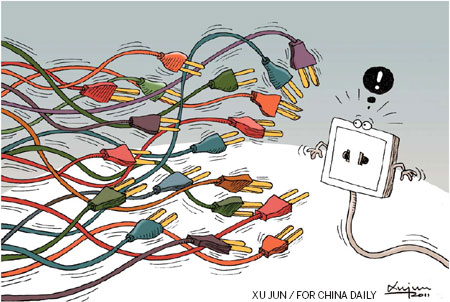Energy
Reform the key to avoid future blackouts
Updated: 2011-06-10 11:48
By Lin Boqiang (China Daily European Weekly)
|
 |
The current power shortage in several provinces in China is drawing a lot of attention but the good thing is that it's happening in the slack season. The bad thing is that the peak of summer is nearly upon us, meaning the power shortage is expected to be a major issue.
China's rapid economic growth is fueling growth in both energy usage and power demand, the two key components to China's development. The occasional power shortage is part of high economic growth. What we need to do, however, is avoid shortages at certain costs.
There are many factors contributing to the power shortage, including low hydropower production because of insufficient rainwater this year, the nation's poor coal transportation system and the inadequate transmission of power that has led to the inability to transmit surplus power from western to eastern parts.
But the main reason for the unexpected power shortage is the rise in coal prices without an adjustment in electricity tariffs over the past few years. With increasing coal prices, most of the coal-fired power plants in China are losing money. They are generating more power but losing in the end. With the demand for power growing, if power plants are not able to produce enough power, we will have power shortages.
Coal plants are currently generating a low output of energy. It is estimated that they are on average generating about 5,100 to 5,200 hours, as compared to an average of 6,000 hours in 2004.
What I am trying to say is that, if coal-fired power plants want to produce more power, they should be able to do that.
Another problem is that the government has set a ceiling on thermal coal contract price, meaning they are not allowed to raise prices past a certain threshold. Coal producers are also lacking incentive to honor the thermal coal contract. This adds difficulties to coal fired power generation.
There's also another problem: The power shortage could also lead to a diesel shortage.
Although the cost of generating power by diesel is higher than the cost of coal power, small- and medium-sized enterprises will have to apply diesel power generation when facing the problem of old coal generators and inevitably blackouts.
We saw this happen in the second half of last year when the government limited the power supply to enterprises in an effort to meet energy conservation targets.
Compounding the current power shortage are the high prices for oil. The government has failed to sufficiently adjust the prices of domestically refined oil products, which has led to a loss in refinery enterprises. If there is a loss in the number of enterprises and less oil is produced, in the long term more diesel will be used and that could result in a diesel shortage.
Solutions to the shortage
Since coal power accounts for 75 percent of China's total power capacity, to effectively address the current power shortage, we need to focus on coal power production.
One short-term solution would be to provide incentives for increasing the generation of power.
This could be done by adjusting grid tariffs, which is already being implemented by the government. But it's not enough. Coal prices also need a control for the power tariff adjustment to be meaningful.
To encourage coal producers to honor limits on thermal coal prices, we should use the same price ceiling for all coals. Further, since most of them are State-owned enterprises, administrative advisers should also be employed to convince coal and power producers that the power shortage should be addressed immediately.
One good thing about this unexpected power shortage is that it forces us to seriously consider the entire electricity production chain. This could lead us to further reforming how we produce power and establishing a sustainable pricing system to avoid future power shortages.
The government should also consider resuming the linking of prices of coal and electricity that was first done in 2004. Basically, if the price of coal keeps increasing, so should electricity. This is the midterm solution: Setting up a transparent link between coal prices and power tariffs. If China won't let power tariffs be determined by the market, a price linkage system could be an effective method to ensure consistency between coal price increases and electricity tariff adjustments.
In 2004, the Chinese government started the linkage mechanism between coal and electricity to address the conflicts between coal and electricity. The government applied the mechanism twice, in May 2005 and June 2006. Due to large hikes in coal prices, the linkage system was later discontinued.
A study was then carried out on the impacts of the linkage mechanism to determine if it had been implemented according to government regulations. The results indicated that if the linkage mechanism had been implemented, the on-grid power tariff and end consumer tariff should have been increased. However, the implementation of the linkage mechanism would have small negative impacts on both GDP growth and employment.
In addition, the implementation of the linkage mechanism could contribute to a better industrial structure. Results from the study indicated that although the power tariff increases the production costs of industries, there would be a larger impact on energy intensive industries. Implementing the linkage mechanism could lead to savings in energy and reductions in energy usage.
One problem is that when the power tariff goes up, coal prices follow. For the linkage mechanism to properly work, it is necessary to stabilize coal prices. Coal resources are mainly State-owned in China and the coal is mainly provided by the large State-owned coal enterprises. Therefore, when coal prices go up rapidly, the central government should consider imposing a windfall tax on coal. This could be done by estimating production costs and other related expenses and making sure that enterprises have enough left to sustain their developments. Collecting a windfall tax could provide coal enterprises incentive to sell more coal and not at high prices.
In addition, the central government could use the revenues from the windfall tax to set up a special fund for stabilizing power tariffs and subsidizing target groups. It is important that the windfall tax be collected by the central government, as local governments might have incentives to return the windfall tax revenue to their coal enterprises and therefore, defeat the purpose of the windfall tax.
Without a proper linkage between coal prices and power tariffs, small increases in the price of coal could force electricity enterprises to cut their costs by improving efficiency. But a substantial increase in coal prices might not necessarily mean power companies are going to be more efficient. Large and persistent losses might actually force power companies to take actions that could reduce their efficiency. These actions include deviating away from their core business and devoting too much effort into negotiating power tariffs. All these eventually add to the costs of the supply of electricity.
A pricing mechanism is very important for the energy industry to develop. Their business operations and investments will face great uncertainty without a transparent pricing mechanism. Under government price settings and without a pricing mechanism, any tariff adjustments will be difficult.
The long-term solution to this is to reform the market.
The long-term tariff reform could be divided into three steps. First, the reform should focus on the price linkage between coal and electricity, with an effort to gradually modify the linkage mechanism toward market pricing. Second, the government should progressively perfect the pricing mechanism by continually carrying out related reforms, such as implementing progressive block tariffs for the residential sector, simplifying the power tariff structure, improving peak-time-use of tariffs, and preparing other reforms. Ultimately, the government will, together with power market reforms, hand the power tariff over to the market.
The window of opportunity for tariff reforms is important because it affects results and how reforms are accepted. For energy pricing reforms, the best opportunity occurs when energy prices are low and energy supply is sufficient. It seems that such an opportunity might never come.
The author is the director of China Center for Energy Economics Research at Xiamen University.
Specials

Birthday a new 'starting point'
China's national English language newspaper aims for a top-notch international all-media group.

Room at the inn
The Chinese hotel industry experiences a building boom, prompting fears of oversupply.

Pearls of wisdom
Chinese pearl farmers dominate the world market but now want to work smarter, not harder